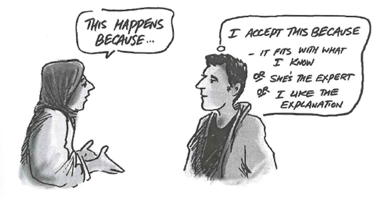4.3 Appreciating epistemological issues
Common sense tells me my experience and understanding of the world are limited. I am 185 cm in height. That limits my view of the world. It may not matter much that I cannot see what my house looks like from above but it does mean there will be things going on in the roof I may not notice until they impinge on areas that I can experience.
More significantly, there is a real limitation on understanding the experiences of other people. You might tell me about your experience but your description is likely to be only a partial representation and, however good your description, I cannot share your experience. I can only construct my own mental representation of what your experience might be like. But the limitations on my understanding of the world are even more fundamental than this.
My mental image of the world is a model. It is a partial representation of reality based on the partial knowledge I have of the external world. So, when I think I am thinking about the world I am thinking about my model of the world. This model of the world is built up in a way that is itself a model. So I am using a model, built by a model, to represent the world I think I see.
This has important implications. The model that represents the world tells me what I see and tells me what to see. The model both limits what I see and reinforces itself. When I think about the world, I am thinking about my own thinking; I have no direct access to the world at all.
Many people find this idea unsettling when they first meet it. It seems to defy common sense. It raises the question of how real the so-called real world really is.
Many people think of the brain as very similar to a computer. Both have a similarly large proportion of ‘processors’ operating on internally generated signals. But there is an important and absolutely fundamental difference. The computer does not create its own meanings. The computer, even if using artificial intelligence programmes, has no capacity for deciding, for example, which are its favourite paintings in the National Gallery. I do. I have a history of interacting with external stimuli that generate new ways of interacting with further stimuli and the internal structure of my brain changes as a result. The computer’s ways of dealing with data are not the result of its own self-production, but of its analysis of what has already been produced. The way the computer works remains the same, whether it is processing pictures from the National Gallery or large amounts of text to answer a query. The rules that relate input to output are constant over time.
The question of what I can know about the outside world is an ancient one and has always been central in philosophy under the theme of epistemology. Epistemology is the branch of philosophy that deals with knowledge and knowing: how do I know about the outside world? How do I know my senses are not fooling me? What constitutes evidence about the world?
Neither discussions about modelling, nor the insights of philosophy, can tell me how true my internal representations of the world are, but neurological studies seem to suggest the outside world is unknowable as it is. This course considers this important issue. Epistemology becomes a central concern. This contrasts sharply with many other courses where epistemology is never addressed. The world is assumed to be ‘out there’ and more-or-less as it appears.
Recognising the world is unknowable as it is presents me with a choice. How do I deal with the day-to-day observations and events that seem to emerge from it? Each person, once they become aware of this unknowability, is confronted with, and needs to make their own choice.
Each choice is individual but seems to cluster around three main poles:
- The first of these is to adopt a stance that the world is more-or-less as I see it, and to ignore the incompleteness of my viewpoints and my representations. This is equivalent to saying ‘there is no epistemological problem about the world as I see it’.
- The second is to decide that the world is more-or-less as I see it but to recognise that my viewpoint is limited and the view-from-here may be misleading because it is only partial – there is no view of the roof, to use my previous metaphor. This is a stance that accepts that I must be careful to explore the world as fully as I can because I cannot see everything and may be misled.
- The third pole is to take on fully the implications of the world’s unknowability. This stance demands that I always carry an awareness that I will never know the world and must therefore always be trying to account for my own role in my perceptions of the world.
Consciously making the choice between these poles, and all the variants between, is an act of epistemological awareness.

